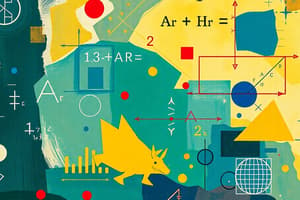Podcast
Questions and Answers
What is the correct order of operations to evaluate the expression $3 + 5 \times (2 - 1)$?
What is the correct order of operations to evaluate the expression $3 + 5 \times (2 - 1)$?
- First subtraction, then addition, then multiplication.
- First multiplication, then subtraction, then addition. (correct)
- First addition, then subtraction, then multiplication.
- First multiplication, then addition, then subtraction.
Which of the following describes a linear function?
Which of the following describes a linear function?
- $y = mx + b$, where $m$ is the slope. (correct)
- $y = \sin(x)$
- $y = ax^2 + bx + c$
- $y = e^x$
What is the value of the greatest common divisor (GCD) of the numbers 18 and 24?
What is the value of the greatest common divisor (GCD) of the numbers 18 and 24?
- 3
- 9
- 6 (correct)
- 12
Which of the following statements best describes the Fundamental Theorem of Calculus?
Which of the following statements best describes the Fundamental Theorem of Calculus?
In a normal distribution, which of the following is true about the mean, median, and mode?
In a normal distribution, which of the following is true about the mean, median, and mode?
Flashcards are hidden until you start studying
Study Notes
Key Areas of Mathematics
-
Arithmetic
- Basic operations: addition, subtraction, multiplication, division.
- Fractions, decimals, and percentages.
- Order of operations (PEMDAS/BODMAS).
-
Algebra
- Variables and constants.
- Expressions, equations, and inequalities.
- Functions: linear, quadratic, polynomial.
- Solving equations (factoring, substitution).
-
Geometry
- Basic shapes: triangles, circles, rectangles, polygons.
- Properties of angles, lines, and symmetry.
- Area and perimeter formulas.
- Volume and surface area of solids.
-
Trigonometry
- Sine, cosine, tangent functions.
- Right triangle relationships.
- Unit circle and radian measure.
- Trigonometric identities and equations.
-
Calculus
- Limits and continuity.
- Derivatives: definition, rules (product, quotient, chain).
- Integrals: definite and indefinite integrals.
- Fundamental Theorem of Calculus.
-
Statistics and Probability
- Data representation: mean, median, mode, range.
- Probability concepts: events, independent/dependent events.
- Distributions: normal, binomial, Poisson.
- Hypothesis testing and confidence intervals.
-
Number Theory
- Prime numbers and composite numbers.
- Divisibility rules and greatest common divisor (GCD).
- Least common multiple (LCM).
- Modular arithmetic.
Mathematical Thinking
- Problem-solving strategies: breaking down problems, logical reasoning.
- Mathematical proofs: direct proof, proof by contradiction, induction.
Important Symbols
- = Equal
- ≠ Not equal
- <, > Less than, greater than
- ≤, ≥ Less than or equal to, greater than or equal to
- ∑ Summation
- ∏ Product notation
Study Tips
- Practice regularly with a variety of problems.
- Visualize concepts through diagrams and graphs.
- Utilize online resources for additional explanations and examples.
Key Areas of Mathematics
-
Arithmetic
- Involves fundamental operations: addition, subtraction, multiplication, and division.
- Covers fractions, decimals, and percentages for numerical representations.
- Order of operations follows PEMDAS (Parentheses, Exponents, Multiplication and Division, Addition and Subtraction) or BODMAS (Brackets, Orders, Division and Multiplication, Addition and Subtraction).
-
Algebra
- Utilizes variables and constants to form expressions and equations.
- Includes inequalities and functions such as linear, quadratic, and polynomial.
- Solving equations can involve factoring and substitution techniques.
-
Geometry
- Focuses on basic shapes: triangles, circles, rectangles, and polygons.
- Studies properties of angles, lines, and concepts such as symmetry.
- Contains formulas for calculating area, perimeter, volume, and surface area of various shapes.
-
Trigonometry
- Explores sine, cosine, and tangent functions to understand right triangle relationships.
- Introduces the unit circle and radian measure for angle measurement.
- Examines trigonometric identities and equations for solving related problems.
-
Calculus
- Examines limits and continuity as foundational concepts.
- Defines derivatives, including rules for product, quotient, and chain rules.
- Investigates integrals, distinguishing between definite and indefinite integrals, alongside the Fundamental Theorem of Calculus.
-
Statistics and Probability
- Involves data representation through mean, median, mode, and range.
- Covers probability concepts such as events, independent and dependent events.
- Discusses various distributions: normal, binomial, and Poisson, alongside hypothesis testing and confidence intervals.
-
Number Theory
- Studies prime numbers and composite numbers focusing on their properties.
- Includes divisibility rules, calculating the greatest common divisor (GCD), and the least common multiple (LCM).
- Introduces modular arithmetic for working with remainders.
Mathematical Thinking
- Emphasizes problem-solving strategies such as breaking down complex problems and applying logical reasoning.
- Utilizes mathematical proofs, including direct proofs, proofs by contradiction, and mathematical induction for validating statements.
Important Symbols
- = Indicates equality.
- ≠ Represents not equal to.
- <, > Denote less than and greater than.
- ≤, ≥ Represent less than or equal to and greater than or equal to.
- ∑ Denotes summation for adding sequences.
- ∏ Represents product notation for multiplying sequences.
Study Tips
- Regular practice with a variety of problems enhances understanding and retention.
- Visualization of concepts through diagrams and graphs aids in comprehension.
- Online resources provide additional explanations and examples for challenging topics.
Studying That Suits You
Use AI to generate personalized quizzes and flashcards to suit your learning preferences.




